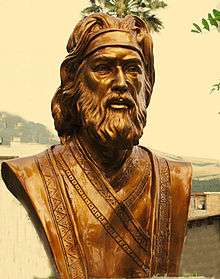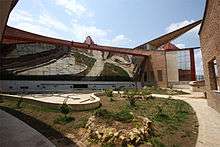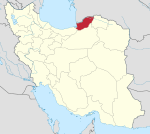Gorgan
| Gorgan گرگان | |
|---|---|
 Gorgan | |
| Coordinates: 36°50′19″N 54°26′05″E / 36.83861°N 54.43472°ECoordinates: 36°50′19″N 54°26′05″E / 36.83861°N 54.43472°E | |
| Country |
|
| Province | Golestan |
| County | Gorgan |
| Bakhsh | Central |
| Area | |
| • Total | 1,700 km2 (656 sq mi) |
| Elevation | 1,350 m (4,430 ft) |
| Population (2011) | |
| • Total | 329,536[1] |
| Time zone | IRST (UTC+03:30) |
| • Summer (DST) | IDST (UTC+04:30) |
| Gorgan at GEOnet Names Server | |
Gorgan ![]() pronunciation (Persian: گرگان;[2] formerly Astrabad or Astarabad (استرآباد),[3][4] is the capital of Golestan Province, Iran. It lies approximately 400 kilometres (250 mi) to the north east of Tehran, some 30 km (19 mi) away from the Caspian Sea. In the 2006 census; its population was 269,226, in 73,702 families.[5]
pronunciation (Persian: گرگان;[2] formerly Astrabad or Astarabad (استرآباد),[3][4] is the capital of Golestan Province, Iran. It lies approximately 400 kilometres (250 mi) to the north east of Tehran, some 30 km (19 mi) away from the Caspian Sea. In the 2006 census; its population was 269,226, in 73,702 families.[5]
Name
The Modern Persian word Gorgān (گرگان) is derived from Middle Persian Gurgān (𐭢𐭥𐭫𐭢𐭠𐭭), itself from Old Persian Varkāna (𐎺𐎼𐎣𐎠𐎴), the Achaemenid satrapy southeast of Caspian Sea (encompassed all of the present day Golestan Province, as well as some eastern parts of the Mazandaran province, and some southern parts of the modern-day Turkmenistan), which is reflected in Greek sources as Hyrcania (Ὑρκανία), Hyrcani or Hyrcana. The region is also mentioned in Avesta as Vəhrkāna (𐬬𐬆𐬵𐬭𐬐𐬁𐬥𐬀). The name is derived from the Proto-Iranian word *vrka-, meaning "wolf".
In post-Islamic Persia the city was known as Jurjān (جرجان), the Arabized form of the Persian word.
The Caspian form of the name is Wergen.
In modern times and until 1937, the city used to be known as Astarābād or Estarābād (استرآباد), which also can be read as Ester-ābād ("City of Esther"), based on which some has theorized that it refers to Esther, wife of the Persian King Xerxes I.
History
There are several archaeological sites near Gorgan, including Tureng Tepe and Shah Tepe, in which there are remains dating to the Neolithic and Chalcolithic eras.
According to the Greek historian Arrian, Zadracarta was the largest city of Hyrcania and site of the "royal palace".[6] The term means "the yellow city", and it was given to it from the great number of oranges, lemons, and other fruit trees which grew in the outskirts of that city.[7]
Hyrcania became part of the Achaemenid Empire during the reign of Cyrus the Great (559-530 BC), its founder, or his successor Cambyses (530-522 BC).
The Great Wall of Gorgan, the second biggest defensive wall in the world, was built in the Parthian and Sassanian periods.
At the time of the Sassanids, "Gurgan" appeared as the name of a city, province capital, and province.[8]
Gurgan maintained its independence as a Zoroastrian state even after Persia was conquered by the invading Arab Muslims in 8th century.
In 1210, the city was invaded and sacked by the army of Kingdom of Georgia under command of the brothers Mkhargrdzeli.[9][10]
The "Old Gorgan" was destroyed during the Mongol invasion in the 13th century, and the center of the region was moved to what was called "Astarabad", which is currently called "Gorgan".
Gurgan with its surrounding regions was sometimes considered as part of the Parthia (the Greater Khorasan) or the Tabaristan regions.
Astarabad was an important political and religious city during the Qajar dynasty.
Geography and climate
The wide Dasht-e Gorgan (Plains of Gorgan) are located north of the city and geographically bounded by 37°00' - 37°30' north latitude and 54°00' - 54°30' east longitude, covering an area of about 1,700 square kilometres (660 sq mi).
Some 150 km (93 mi) east of Gorgan is the Golestan National Park, home to a big portion of the fauna of Iran.
In general, Golestan has a moderate and humid climate known as "the moderate Caspian climate." The effective factors behind such a climate are: Alborz mountain range, direction of the mountains, height of the area, neighborhood to the sea, vegetation surface, local winds, altitude and weather fronts. As a result of the above factors, three different climates exist in the region: plain moderate, mountainous, and semi-arid. Gorgan valley has a semi-arid climate. The average annual temperature is 18.2 °C (64.8 °F) and the annual rainfall is 600 millimetres (24 in).
| Climate data for Gorgan | |||||||||||||
|---|---|---|---|---|---|---|---|---|---|---|---|---|---|
| Month | Jan | Feb | Mar | Apr | May | Jun | Jul | Aug | Sep | Oct | Nov | Dec | Year |
| Record high °C (°F) | 29 (84) |
32.4 (90.3) |
35 (95) |
39 (102) |
43 (109) |
45 (113) |
44 (111) |
44 (111) |
41.6 (106.9) |
39 (102) |
36 (97) |
29.2 (84.6) |
45 (113) |
| Average high °C (°F) | 12.4 (54.3) |
13.1 (55.6) |
15.3 (59.5) |
21.2 (70.2) |
26.9 (80.4) |
30.9 (87.6) |
32.6 (90.7) |
32.7 (90.9) |
29.9 (85.8) |
24.8 (76.6) |
18.8 (65.8) |
14.3 (57.7) |
22.74 (72.93) |
| Average low °C (°F) | 3.4 (38.1) |
3.8 (38.8) |
6.1 (43) |
10.7 (51.3) |
15.5 (59.9) |
19.9 (67.8) |
22.8 (73) |
22.9 (73.2) |
19.6 (67.3) |
13.9 (57) |
8.9 (48) |
5.2 (41.4) |
12.73 (54.9) |
| Record low °C (°F) | −10 (14) |
−6 (21) |
−3.2 (26.2) |
0 (32) |
2.8 (37) |
10 (50) |
15 (59) |
13 (55) |
9 (48) |
3 (37) |
−2 (28) |
−7 (19) |
−10 (14) |
| Average precipitation mm (inches) | 55.0 (2.165) |
55.8 (2.197) |
79.4 (3.126) |
52.8 (2.079) |
44.1 (1.736) |
33.4 (1.315) |
22.2 (0.874) |
27.3 (1.075) |
38.9 (1.531) |
66.1 (2.602) |
68.5 (2.697) |
57.5 (2.264) |
601 (23.661) |
| Average precipitation days (≥ 1.0 mm) | 7.4 | 8.0 | 10.5 | 8.0 | 6.1 | 4.2 | 3.7 | 4.2 | 5.2 | 5.7 | 6.7 | 6.8 | 76.5 |
| Average relative humidity (%) | 73 | 73 | 74 | 72 | 67 | 64 | 65 | 68 | 69 | 70 | 73 | 74 | 70.2 |
| Mean monthly sunshine hours | 135.3 | 128.1 | 132.3 | 164.6 | 207.6 | 220.4 | 221.9 | 220.5 | 196.3 | 196.4 | 151.1 | 132.8 | 2,107.3 |
| Source: Synoptic Stations Statistics | |||||||||||||
Demographics
The population of the city has been 329,536 as of 2011.
Majority of people of Gorgan speak Persian. A big portion of the city are migrants from nearby regions, including Mazanderanis, Azeris, people from Semnan and Khorasan provinces, as well as some Turkmens, and a small population of Kazakhs.
Gorgani, a dialect of Mazanderani language, was formerly spoken in the city, but it is extinct now, and only several of its words have remained in the accent of the Persian-speakers of the city.
Notable people
Historical figures

- House of Karen, an aristocratic feudal family first attested in the Arsacid era, belonged to the region of Hyrcania.
- Fakhroddin Asaad Gorgani, Persian poet and the composer of Vis and Ramin.
- Abu Sa'id al-Darir al-Jurjani, 9th century astronomer and mathematician
- Al-Masihi, 10th century physician and teacher of Avicenna
- Abd al-Qāhir al-Jurjānī, 11th century grammarian and literary theorist
- Zayn al-Din al-Jurjani, 12th century royal physician
- Fazlallah Astarabadi (Naimi), 14th century mystic and founder of Hurufism
- Rustam Gorgani, 16th century physician
- Mir Fendereski, philosopher, poet and mysti
- Mir Damad, 17th century Islamic scholar and Neoplatonic philosopher
- Mirza Mehdi Khan Astarabadi, 18th century chief minister to Nader Shah
- Bibi Khatoon Astarabadi, a notable writer, satirist, and one of the pioneering figures of the women's movement of Iran
- Firishta, historian
- Sardar Rafie Yanehsari, Governor of Astarabad
Contemporary figures
- Mohammad Reza Lotfi, Traditional Persian musician.
- Nader Ebrahimi, author, poet, director, and researcher.
- Maryam Zandi, photographer.
Culture and art
Gorgan (as well as the whole Golestan province) has a world-famous carpet and rug industry, the Turkmen rug, made by Turkmen people. The patterns of these carpets are derived from the ancient Persian city of Bukhara, which is now in modern-day Uzbekistan.
 Ceramic bowl from the Seljuk period
Ceramic bowl from the Seljuk period- Ceramic compound vessel, 12-13th century, Gorgan,Abgineh Museum of Tehran
 Farah Pahlavi visiting Turkmen rugs in Gorgan
Farah Pahlavi visiting Turkmen rugs in Gorgan Baqeri House (fa), a traditional house built in Pahlavi era
Baqeri House (fa), a traditional house built in Pahlavi era
Entertainment locations
- Nahar Khoran Forest (ناهارخوران)
- Alangdare Forest (النگدره)
- Ziarat Village (روستای زیارت)
- Hezarpich Hill (هزارپیچ)
- Emadiyyeh School
- Sorkhankalateh Hill (سرخنکلاته)
- Ismail Shirine Sorkhankalateh
- Qajar era underground bathroom, Sorkhankalateh
- Nahar Khoran Forest
- Alangdarreh Forest

 Ziarat Waterfall, Ziarat Village
Ziarat Waterfall, Ziarat Village
- Cinemas
Capri Cinema (کاپری), Bahman Cinema (سینما بهمن), and Asr-e Jadid Cinema (سینما غصر جدید), formerly called Moulin-Rouge Cinema (سینما مولنروژ), are among the oldest cinemas in Gorgan.
Education

- Islamic Azad University of Gorgan
- Golestan University of Medical Sciences[11]
- Gorgan University of Agricultural Sciences & Natural Resources
- Mirdamad Institute of Higher Education
- Lamei Gorgani Institute of Higher Education
- Hakeem Jorjani Institute of Higher Education
Transportation
There is an international airport near the city.
Sports
Shahrdari Gorgan BC, which compete in the Iranian Basketball Super League, is particularly popular in Gorgan.
Currently the main football team of Gorgan is Etka Gorgan F.C., which competes in the Azadegan League.
Sister cities
-
 Aktau, Kazakhstan[12]
Aktau, Kazakhstan[12]  Samsun, Turkey (2006)
Samsun, Turkey (2006)
See also
References
- ↑ "Iran: Major Cities - Population Statistics in Maps and Charts".
- ↑ Also Romanized as Gorgān, Gurgān, and Gurgan. Persian pronunciation: [goɾˈgɒn]
- ↑ Also Romanized as Astarābād, Asterabad, and Esterabad. Persian pronunciation: [ʔæsˌtæɾɒːˈbɒːd]
- ↑ Gorgan can be found at GEOnet Names Server, at this link, by opening the Advanced Search box, entering "-3064853" in the "Unique Feature Id" form, and clicking on "Search Database".
- ↑ "Census of the Islamic Republic of Iran, 1385 (2006)". Islamic Republic of Iran. Archived from the original (Excel) on 2011-11-11.
- ↑ Arrian (1884). "Chapter XXV: March to Bactra.—Bessus Aided by Satibaezanes.". The Anabasis of Alexander. 3. Translated by E.J. Chinnock. London: Hodder and Stoughton. p. 191–193.
- ↑ electricpulp.com. "GORGAN v. Pre-Islamic history – Encyclopaedia Iranica".
- ↑ Bivar, A.D.H. "Gorgan" Encyclopædia Iranica online
- ↑ Yar-Shater, Ehsan (2010). Encyclopaedia Iranica, Volume 2, Parts 5-8. Abingdon, United Kingdom: Routledge & Kegan Paul. p. 892.
- ↑ Brosset, Marie-Felicite (1858). Histoire de la Géorgie depuis l'Antiquité jusqu'au XIXe siècle. France: imprimerie de l'Académie Impériale des sciences. p. 468-472.
- ↑ "Golestan University of Medical Sciences- دانشگاه علوم پزشكي گلستان - Golestan University of Medical Sciences - دانشگاه علوم پزشكي گلستان". GOUMS. Retrieved 2013-01-26.
- ↑ KZ-Today September 11, 2006
External links
| Wikimedia Commons has media related to Gorgan. |

